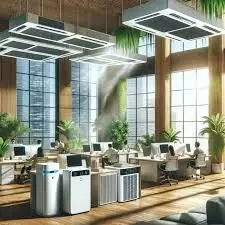Live
- NFR issues notice to 20 GCPA leaders for disrupting railway services
- Bengal school job case: CBI submits third supplementary charge sheet
- Opelka beats Mpetshi Perricard in Brisbane, reaches first final since 2022
- RJD to convene national executive meet in Patna on Jan 18
- ‘Temple’ shirt row continues in Kerala
- Rajnath Singh to present 'chadar' at Ajmer Sharif Dargah on Jan 5
- No Entry to Collectorate Without a Helmet - Collector Badavath Santosh
- Every Pregnant Woman Deserves Safe Motherhood -DMHO Dr. K.V. Swarajyalakshmi
- Human Metapneumovirus (HMPV) Surge in China: Is It Similar to Covid-19?
- Bengaluru Gears Up for Anniversary Show of Classic Motorcycles
Just In
Impact of surging air pollution on IAQ of commercial and industrial spaces


Impact of surging air pollution on IAQ of commercial and industrial spaces
Amid increasing outdoor air pollution, air purification systems are essential for enhancing indoor air quality in commercial and industrial settings, efficiently blocking pollutants from infiltrating indoor spaces.
The onset of winter marks a significant rise in air pollution. Every year, there is profound deterioration in the quality of air during the period, and this year as well, the AQI of the capital city plunged to the ‘severe category’ for eight consecutive days. Though the pollution levels have reduced in the past few days, with AQI improving marginally to 310 as per the Central Pollution Control Board records, the vulnerability to pollution still persists in the city. Additionally, experts have shown concerns about the quality slipping back to the severe category with hazy conditions still prevailing in major parts of the city and its adjoining areas.
With the capital city striving to counter the air pollution, it is important to understand that the impact is not just limited to outside but is also responsible for influencing the air quality within the enclosed spaces. The worst affected are commercial and industrial spaces facing the challenge of poor indoor air quality (IAQ) as contaminated air remains trapped within the space. Given the large and complex structure of these spaces, such as offices, schools, airports, hotels, etc., they are often marked by excessive buildup of pollutants, dust, and allergens due to packed buildings. This in turn leads to a hike in levels of PM2.5, PM10, carbon dioxide, VOCs, etc., giving rise to a range of respiratory problems such as bronchitis, asthma, and lung inflammation, along with cardiovascular issues and neurological disorders in a person.
Moreover, as per the study by IIT Kanpur, the level of PM 2.5 peaks during the month of November, where the pattern continues in December as well, with pollution still being a matter of concern. With PM 2.5 levels surpassing the mark of 1000 in the 3rd week of November, it becomes essential to improve the IAQ of the large spaces. Furthermore, long-term exposure to poor IAQ has also been linked to the development of a condition called Sick Building Syndrome (SBS) among the occupants. In this condition, people complain about issues such as fatigue, headaches, lethargy, nausea, wheezing, throat irritation, etc. In addition to this, SBS is also responsible for reduced productivity and absenteeism in the person, as unhealthy indoor air can also affect the physical and mental well-being of people.
However, given the inherently complicated structure of commercial and industrial spaces, improving the IAQ cannot be done alone and requires the intervention of advanced technologies. Here, installing Air Purification Systems (APS) can come in handy for maintaining good IAQ across the space by conducting the removal of outdoor air pollutants at the source itself. It offers a proactive solution with the help of a "beginning-of-the-tube" system where purification of air is performed at the source by harnessing the benefits of advanced filtration technologies. The APS systems exercise an edge over the other standard air purifiers by purging the air before it enters the facility rather than treating the outdoor air inside the building, risking the mixture of outside contaminated air with the indoor environment.
In order to address the air quality issues proficiently, the APS systems employ innovative solutions in the form of honeycomb-designed chemical filters. They conduct 100% elimination of gaseous contaminants before they infiltrate indoor spaces and check the entry of harmful particulate and gaseous pollutants at multiple levels. To further fortify the process, the systems also prevent the infiltration of contaminated air into the building by maintaining positive pressure across the space. Along with this, it ensures thorough cleaning of outside air, making use of proper particulate and chemical filtration.
Looking at the health repercussions of poor IAQ in large spaces, adopting advanced Air Purification Systems can go a long way in curtailing the contamination of air indoors. With rising outdoor air pollution, these systems play a crucial role in improving indoor air quality in commercial and industrial spaces by effectively preventing pollutants from entering the indoor environment.
(This article is authored by Varun Pahwa, President, Desiccant Rotors International)

© 2024 Hyderabad Media House Limited/The Hans India. All rights reserved. Powered by hocalwire.com






